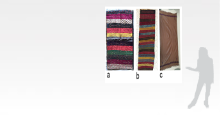
a) YAZD, IRAN, LATE 19TH CENTURY
Handspun and handwoven, hand embroidered, cotton lining, natural dyes
23 x 29.75 in (59 x 76 cm)
b) YAZD, IRAN, CIRCA 1930
Handspun and handwoven cotton, hand embroidered, printed cotton, natural dyes
43.5 x 18 in (111 x 46 cm)
c) BIRJAND, IRAN, CIRCA 1930
Handspun and handwoven natural golden-coloured cotton, hand embroidered with silk thread
86.75 x 46.75 in (220.4 x 119.1 cm)
(Set of three)
NON EXPORTABLE
Life was difficult in 19th century Iran for Zoroastrians and there were a number of regulations governing them that were intended to marginalise and distinguish them from the majority Muslim population. One directive included a strict dress code. Zoroastrian men were obliged to wear garments of yellow ochre or unbleached cloth. In Yazd and Kerman, Zoroastrians were not permitted to buy cloth by the yard. As a result, shopkeepers would collect strips of leftover fabric and leave these in bins outside their shops for Zoroastrians to buy. These were then laboriously stitched together to make garments such as the loose voluminous shalwar and kamiz for women.
The present lot consists of two pieces of textiles sewn during the 19th and early 20th century for Zoroastrian women in Yazd. They are sections from one-leg of a multi-pieced shalwar worn by Zoroastrian brides. They are made of narrow strips (27 for a and 23 for b) joined by fine running stitches referred to as dandan-e-mush or 'the teeth of a mouse.' The colours chosen for the strips range from black to yellow, maroon, blue, and white, to red and green. These refer to the concept of haftrang or seven colours, that were considered auspicious, or seven colours, that were considered auspicious, implying that the wearer was ritually pure. Each piece is embroidered with vertical lines of small motifs such as the three-legged ass, Cypress tree and the kar fish, taken from Zoroastrian mythology.
These rare shalwar pieces share a close connection to Sindhi embroidery. It would have been worn under a long, loose-fitting kamiz along with a head scarf. These lots were acquired by Jasleen Dhamija during her travels in Iran in 1971.
Birjand in eastern Iran, bordering Balochistan, has a strong Zoroastrian influence. This simple shawl or wrap, known as a chador (c), gets its golden hue from a natural golden coloured cotton cultivated in Birjand. It has a narrow woven border of squares and diamonds woven in seven auspicious colours. The corner symbols on a stand represent the 'Sacred Eye.'
The chador worn by Zoroastrian women is shorter and comes up to the calf, while Muslim women in Iran wore chadors that extended to their ankles.
Other similar works in:
this auction
|
entire site

Lot
45
of
82

WOVEN TREASURES: TEXTILES FROM THE JASLEEN DHAMIJA COLLECTION
19-20 OCTOBER 2016
Estimate
Rs 5,50,000 - 7,50,000
$8,335 - 11,365
RESERVE NOT MET

Size Size

Height of Figure: 6'